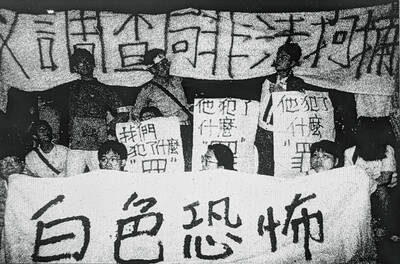For some of us, the dating app Tinder suggests a slot machine for sex, a game for singles featuring one too many bathroom selfies.
For Casey Napolitano, a real estate agent in Los Angeles, Tinder is synonymous with love.
Napolitano met her husband, John Napolitano, on the app during her first and only Tinder date. She “swiped right” on a photo of John in a tuxedo giving a speech at a wedding. “It just really turned me on,” she said. Six months later, they bought a house together; a few months later, they were engaged. They have been married for two years now and have a 14-month-old.

Photo: EPA
“Our baby girl is perfect,” the proud new father said.
The Napolitanos’ love story isn’t isolated. According to Jessica Carbino, Tinder’s on-site sociologist who pores over Tinder’s data, more people than ever are committing to relationships thanks to the app, which will have its fifth anniversary in September.
In a report released this week, Tinder conducted two surveys comparing its users with offline daters. (Offline daters fell into three groups: people who have never dated online, people who had dated online in the past but no longer did, and people who had never used online dating but were open to the possibility.)

Photo: EPA
According to Carbino, the findings indicate that Tinder users are more likely to be looking for a committed relationship than are offline daters. She said that the surveys revealed that Tinder users were doing a better job than offline daters of signaling “investment in prospective daters” by asking them questions when originally contacting them, and that they are five percent more likely to say “I love you” to their partners in the first year of dating.
The survey also reveals that while 30 percent of men who are not dating online say it is “challenging to commit,” only nine percent of male Tinder users say they find it difficult to maintain a committed relationship. The results were roughly similar for women.
“When you are dating online, you actually have a very clear idea of what the marketplace is like,” Carbino said. “You are able to have a visual idea of the pool in front of you, whereas the people who aren’t dating online are simply speculating as to what the pool may be like.”
The report looked at a survey administered via the app to 7,072 Tinder users, ages 18 to 36, and a second survey of 2,502 offline daters, ages 18 to 35, conducted by Morar Consulting.
While the surveys were commissioned by Tinder, Carbino said her position as a social scientist was to provide a valid and realistic view of the world.
“The realistic view might not provide what the company wants,” she said, “however it’s my responsibility to do so and provide data that is accurate.”
It is unclear whether the surveys sampled similar and representative demographics, a fact that Jennifer Lundquist, a sociologist at the University of Massachusetts, Amherst who researches online dating, said indicated that more studies were needed to determine if Tinder’s surveys were accurate.
“One issue with the non-online dating comparison group is that given how normalized and destigmatized online dating has become for this age group, it’s unusual not to participate in online dating,” Lundquist said. As a result, she said, the offline daters “may be a weirdly skewed group, or as sociologists would say negatively select.”
Lundquist also questioned the motivations for the survey, pointing to the anecdotal belief among many daters that Tinder’s picture-based feature leads it to be a “hookup” app rather than a mechanism for finding long-term partners.
“It seems like Tinder is trying to work on their image with this survey,” she said.
But despite Tinder’s aims, and researchers’ varying methods, the app’s conclusions about the desire of online daters to commit may not be unfounded. In a 2012 report on a study by the sociologists Michael Rosenfeld and Reuben Thomas published in the American Sociological Review, the researchers found that couples who meet online are no more likely to break up than couples who meet offline. Rosenfeld’s continuing research at Stanford University concludes that couples who meet online transition to marriage more quickly than those who meet offline. (The cohort of couples he studied met in 2009, before Tinder was founded; he is currently gathering data that include users of the app.)
Still, it is unclear whether Tinder’s surveys, even bolstered by larger trends in online dating, will shift the public’s perception of the app. It does not help that in a recent article in The California Sunday Magazine, Tinder’s founder and chairman, Sean Rad, admitted to sexting, or sending sexually explicit messages, with Snapchat users. But perhaps Carbino, who scours Tinder daily, sees what others can’t: humans trying their best to connect. She is single and said she had found, and lost, love on Tinder.

From the last quarter of 2001, research shows that real housing prices nearly tripled (before a 2012 law to enforce housing price registration, researchers tracked a few large real estate firms to estimate housing price behavior). Incomes have not kept pace, though this has not yet led to defaults. Instead, an increasing chunk of household income goes to mortgage payments. This suggests that even if incomes grow, the mortgage squeeze will still make voters feel like their paychecks won’t stretch to cover expenses. The housing price rises in the last two decades are now driving higher rents. The rental market

July 21 to July 27 If the “Taiwan Independence Association” (TIA) incident had happened four years earlier, it probably wouldn’t have caused much of an uproar. But the arrest of four young suspected independence activists in the early hours of May 9, 1991, sparked outrage, with many denouncing it as a return to the White Terror — a time when anyone could be detained for suspected seditious activity. Not only had martial law been lifted in 1987, just days earlier on May 1, the government had abolished the Temporary Provisions Effective During the Period of National Mobilization for Suppression of the Communist

When life gives you trees, make paper. That was one of the first thoughts to cross my mind as I explored what’s now called Chung Hsing Cultural and Creative Park (中興文化創意園區, CHCCP) in Yilan County’s Wujie Township (五結). Northeast Taiwan boasts an abundance of forest resources. Yilan County is home to both Taipingshan National Forest Recreation Area (太平山國家森林遊樂區) — by far the largest reserve of its kind in the country — and Makauy Ecological Park (馬告生態園區, see “Towering trees and a tranquil lake” in the May 13, 2022 edition of this newspaper). So it was inevitable that industrial-scale paper making would

Hualien lawmaker Fu Kun-chi (傅?萁) is the prime target of the recall campaigns. They want to bring him and everything he represents crashing down. This is an existential test for Fu and a critical symbolic test for the campaigners. It is also a crucial test for both the Chinese Nationalist Party (KMT) and a personal one for party Chairman Eric Chu (朱立倫). Why is Fu such a lightning rod? LOCAL LORD At the dawn of the 2020s, Fu, running as an independent candidate, beat incumbent Democratic Progressive Party (DPP) lawmaker Hsiao Bi-khim (蕭美琴) and a KMT candidate to return to the legislature representing